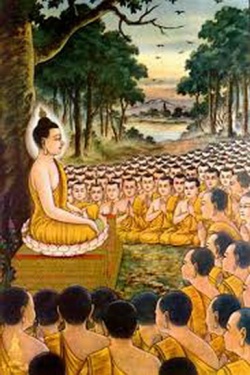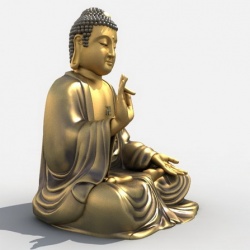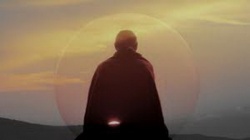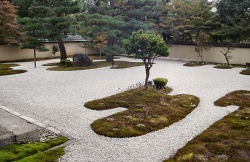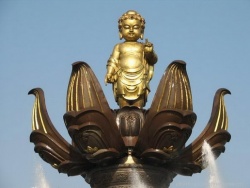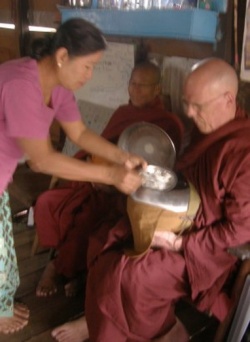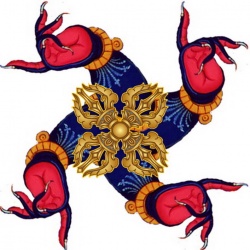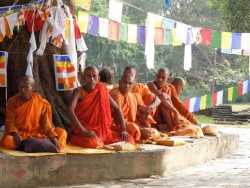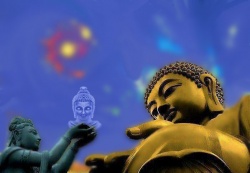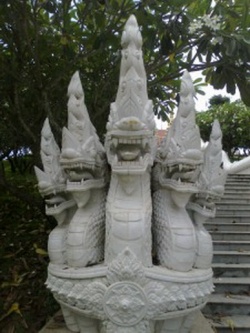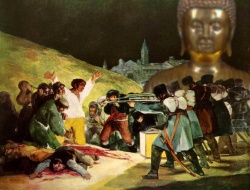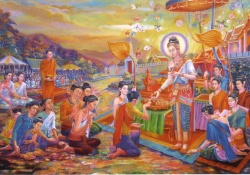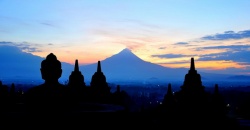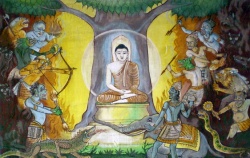Difference between revisions of "Veluvana"
m (Text replacement - "lodgings" to "lodgings") |
|||
| (One intermediate revision by the same user not shown) | |||
| Line 15: | Line 15: | ||
[[Kalandakanivāpa]] (q.v.) is the place nearly always mentioned as the spot where the [[Buddha]] stayed in [[Veluvana]]. | [[Kalandakanivāpa]] (q.v.) is the place nearly always mentioned as the spot where the [[Buddha]] stayed in [[Veluvana]]. | ||
| − | There many [[Vinaya]] {{Wiki|rules}} were passed - e.g., on the keeping of the [[vassa]] (Vin.i.137), the use of [[food]] cooked in the [[monastery]] (Vin.i.210f), the picking of edible ([[kappiya]]) [[fruit]] in the absence of any [[layman]] from whom permission to do so could be obtained (Vin.i.212), surgical operations on [[monks]] (Vin.i.215f), the eating of | + | There many [[Vinaya]] {{Wiki|rules}} were passed - e.g., on the keeping of the [[vassa]] (Vin.i.137), the use of [[food]] cooked in the [[monastery]] (Vin.i.210f), the picking of edible ([[kappiya]]) [[fruit]] in the absence of any [[layman]] from whom permission to do so could be obtained (Vin.i.212), surgical operations on [[monks]] (Vin.i.215f), the eating of sugar (Vin.i.226), the rubbing of various parts of the [[body]] against [[wood]] (Vin.ii.105), the use of the kinds of dwelling (Vin.ii.146) and the use of {{Wiki|gold}} and {{Wiki|silver}} (Vin.ii.196). |
| − | During the [[Buddha]]'s stay at [[Veluvana]], [[Dabba Mallaputta]], at his [[own]] request, was appointed regulator of | + | During the [[Buddha]]'s stay at [[Veluvana]], [[Dabba Mallaputta]], at his [[own]] request, was appointed regulator of lodgings and apportioner of rations, (Vin.ii.74. The [[Buddha]] was at [[Veluvana]] when [[Dabba]] also decided to [[die]]. |
He went there to take leave of the [[Buddha]], Ud.viii.9) and [[Sāriputta]] and [[Moggallāna]] brought back the five hundred [[monks]] whom [[Devadatta]] had enticed away to [[Gayāsīsa]] (Vin.ii.200). The [[Buddha]] spent the second, third, and fourth [[vassas]] at [[Veluvana]]. | He went there to take leave of the [[Buddha]], Ud.viii.9) and [[Sāriputta]] and [[Moggallāna]] brought back the five hundred [[monks]] whom [[Devadatta]] had enticed away to [[Gayāsīsa]] (Vin.ii.200). The [[Buddha]] spent the second, third, and fourth [[vassas]] at [[Veluvana]]. | ||
Latest revision as of 09:34, 8 February 2016
1. Veluvana. A park near Rājagaha, the pleasure garden of Bimbisāra.
When the Buddha first visited Rājagaha, after his Enlightenment, he stayed at the Latthivanuyyāna (Vin.i.35).
The day after his arrival, he accepted the king's invitation to a meal at the palace, at the end of which the king, seeking a place for the Buddha to live "not too far from the town, not too near, suitable for coming and going, easily accessible to all people, by day not too crowded, by night not exposed to noise and clamour, clean of the smell of people, hidden from men and well fitted to seclusion" decided on Veluvana, and bestowed it on the Buddha and the fraternity.
This was the first ārāma accepted by the Buddha, and a rule was passed allowing monks to accept such an ārāma. Vin.i.39f.; according to BuA. (19; cf. ApA.i.75) the earth trembled when the water - poured over the Buddha's hand by Bimbisāra in dedication of Veluvana - fell on the earth. This was the only ārāma in Jambudīpa, the dedication of which was accompanied by a tremor of the earth.
It was the dedication of Veluvana which was quoted as precedent by Mahinda, when he decided to accept the Mahāmeghavana, at Anurādhapura, from Devānampiyatissa (Mhv.xv.17).
The Buddha at once went to stay there, and it was during this stay that Sāriputta and Moggallāna joined the Order. Vin.i.42.
Kalandakanivāpa (q.v.) is the place nearly always mentioned as the spot where the Buddha stayed in Veluvana.
There many Vinaya rules were passed - e.g., on the keeping of the vassa (Vin.i.137), the use of food cooked in the monastery (Vin.i.210f), the picking of edible (kappiya) fruit in the absence of any layman from whom permission to do so could be obtained (Vin.i.212), surgical operations on monks (Vin.i.215f), the eating of sugar (Vin.i.226), the rubbing of various parts of the body against wood (Vin.ii.105), the use of the kinds of dwelling (Vin.ii.146) and the use of gold and silver (Vin.ii.196).
During the Buddha's stay at Veluvana, Dabba Mallaputta, at his own request, was appointed regulator of lodgings and apportioner of rations, (Vin.ii.74. The Buddha was at Veluvana when Dabba also decided to die.
He went there to take leave of the Buddha, Ud.viii.9) and Sāriputta and Moggallāna brought back the five hundred monks whom Devadatta had enticed away to Gayāsīsa (Vin.ii.200). The Buddha spent the second, third, and fourth vassas at Veluvana.
BuA.3; it was while the Buddha was at Veluvana that Devadatta attempted to kill him by causing Nālāgiri to be let loose against him (J.v.335).
It was a very peaceful place, and monks, who had taken part in the first Convocation, rested there, in Kalandakanivāpa, after their exertions. It was there that they met Purāna, who refused to acknowledge the authenticity of their Recital (Vin.ii.289f).
Numerous Jātakas were recited at Veluvana - e.g.,
Asampadāna,
Upahāna,
Ubhatobhattha,
Kandagalaka,
Kālabāhu,
Kukkuta,
Kumbhila,
Kurunga,
Kurungamiga,
Giridanta,
Guttila,
Culladhammapāla,
Cūlahamsa,
Cūlanandiya,
Jambu,
Tayodhamma,
Thusa,
Dummedha,
Dūbhiyamakkata,
Dhammaddhaja,
Nigrodha,
Parantapa,
Pucimanda,
Mangala,
Manicora,
Manoja,
Mahākapi,
Mahāhamsa,
Mūsika,
Romaka,
Rohantamiga,
Ruru,
Lakkhana,
Latukika,
Vānara,
Vānarinda,
Vinīlaka,
Virocana,
Saccankura,
Sañjīva,
Sabbadātha,
Sarabhanga,
Sāliya,
Sigāla,
Sīlavanāga,
Suvannakakkata,
Hamsa and
Hāritamātā.
Most of these refer to Devadatta, some to Ajātasattu, and some to Ananda's attempt to sacrifice his life for the Buddha.
The books mention, in addition, various suttas which were preached there.
Among those who visited the Buddha at Veluvana were several devaputtas:
Dīghalattha,
Nandana,
Candana,
Sudatta,
Subrahmā,
Asama,
Sahali,
Ninka,
Akotaka,
Vetambari and
Mānavagāmiya;
also the
Dhanañjanī
brahmin;
the Bhāradvājas:
Akkosaka,
Asurinda,
Bilangika,
Aggika,
Acela
Kassapa,
Susīma;
the thirty monks from Pāvā (S.ii.187); Theras, like
Mahākappina Aññākondañña (just before his death);
Sonagahapatiputta,
[[[Samiddhi]],
Moliya Sīvaka,
Tālaputa,
Manicūlaka,
Mahā cunda (during his illness), (S.v.181)
Visākha (after his visit to Dhammadīnnā, who preached to him the Culla Vedalla Sutta),
Abhayarājakumāra,
Gulissāni,
Vacchagotta,
Bhūmija,
Samiddhi,
Aciravata,
Sabhiya,
Vassaka,
Suppabuddha,
Pilindavaccha,
Jānussoni and the princess Cundī;
also Bimbisāra's wife, Khemā, who went to Veluvana because she had heard so much of its beauty.
Sāriputta and Ananda visited the Buddha there on several occasions, sometimes alone, sometimes in the company of others, and Ananda lived there for some time after the Buddha's death, and during his stay there preached the Gopakamoggallāna Sutta.
Sāriputta is mentioned as having held discussions there with, among others, Candikāputta and Lāludāyī.
A sermon preached by Mahā Kassapa to the monks at Veluvana is given at A.v.161ff.; for other suttas preached by the Buddha, see also S.i.231; ii.32, 183, 242, 254; iv.20; v.446; Ud.iv.9.
It is said that Māra visited Veluvana several times (E.g., S.i.106f ) in order to work his will on the Buddha.
The Buddha was there when three of the monks committed suicide - Vakkali, Godhika and Channa - and he had to pronounce them free from blame.
News was brought to the Buddha, at Veluvana, of the illness of three of his disciples - Assaji, Moggallāna and Dīghāvu - and he set out to visit them and comfort them with talks on the doctrine.
Near Veluvana was a Paribbājaka Rāma, where the Buddha sometimes went with some of his disciples in the course of his alms rounds.
Two of his discussions there are recorded in the Cūla- and Mahā Sakuladāyī Suttas.
During the Buddha's lifetime, two thūpas were erected at the gate of Veluvana, one containing the relics of Aññā Kondañña (SA.i.219), and the other those of Moggallāna (J.v.127).
Veluvana was so called because it was surrounded by bamboos (velu).
It was surrounded by a wall, eighteen cubits high, holding a gateway and towers (SNA.ii.419; Sp.iii.576).
After the Buddha's death, Dāsaka, Upāli's pupil, lived at Veluvana, and there ordained Sonaka with fifty five companions.
From there Sonaka went to the Kukkutārāma. (Mhv.v.115 f, 122; Dpv.iv.39).
The dedication of Veluvana was among the scenes depicted in the Relic Chamber of the Mahā Thūpa (Mhv.xxx.80).
On one side of the main building of the Veluvana vihāra was a building called Ambalatthika (MA.ii.635).
There was also a senāsana, built for the use of monks practicing austerities (MA.ii.932).
It is said that, after death, Vassakāra was born as a monkey in Veluvana and answered to his name.
He had been told during his lifetime that this destiny awaited him, and therefore took the precaution of seeing that the place was well supplied with fruit trees (MA.ii.854).
According to Hiouen Thsang (Beal, op. cit., ii.159), the Kalandaka nivāpa (Karandavenuvana, as he calls it) lay one li to the north of Rājagaha.
2. Veluvana. A bamboo grove in Kajangalā, where the Buddha once stayed.
The upāsakas of Kajangalā, having questioned the Kajangalā-Bhikkhunī, went to the Buddha there and asked him to verify her answers. A.v.54f
3. Veluvana. A bamboo grove in Kimbilā, where the Buddha stayed and was visited by Kimbila. A.iii.247, 339: iv.84.
4. Veluvana. A monastery in Ceylon, built by Aggabodhi II. It was given by him to the Sāgalikas (Cv.xlii.43).
It probably lay between Anurādhapura and Manihīra, and Sanghatissa once lay in hiding there disguised as a monk (Cv.xliv.29; Cv.Trs.i.77, n.2).
Jetthatissa III. gave to the vihāra the village of Kakkalavitthi. Cv.xliv.99.
5. Veluvana. A monastery erected by Parakkamabāhu I. in the suburb of Vijita in Pulatthipura.
It consisted of three image houses, each three storeys high, a thūpa, a cloister, a two storeyed pāsāda, four gateways, four long pāsādas, eight small ones, one refectory, one sermon hall, seven fire hoses and twelve privies. Cv.lxxiii.152, lxxviii.87f.; see also Cv.Trs.ii.113, n.1.
